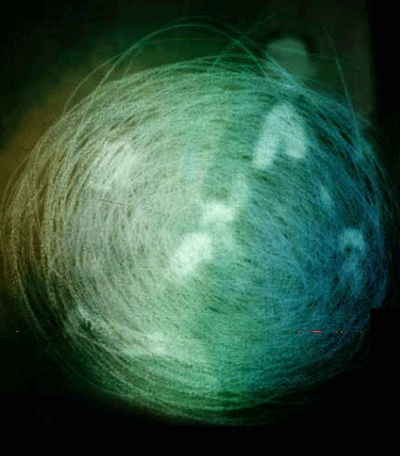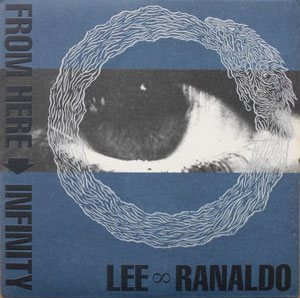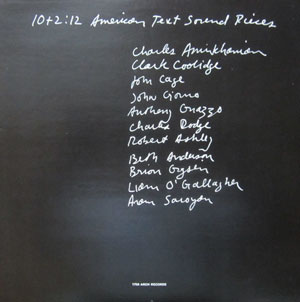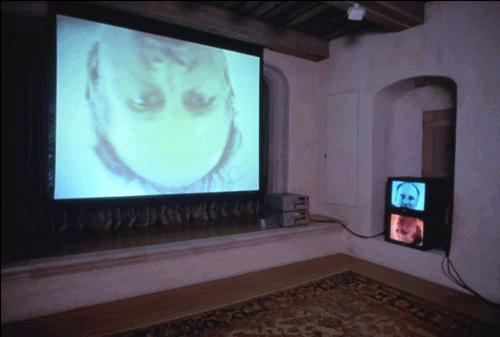SONIC PHANTOMS

Book excerpt
by Barbara Ellison and Thomas Bey William Bailey
Intro by Thomas Bey William Bailey
(April 2021)
In our new book, Sonic Phantoms, we aim at uniquely advancing the literature on sonic experimentation dealing with the sublime act of "listening to listening." From at least the mid-point of the twentieth century, there has been a well-documented interest in reconfiguring the listener as a sound producer or creator, and our work -- affirmed by a number of neuro-scientific discoveries -- similarly springs from the rejection of listening as a purely passive exercise. We submit that one of the key realizations provided upon rejecting the "passive" nature of audio experience is the degree to which we, as humans, ascribe meaning to the apparently meaningless. This is not an activity that has abated with the advancement of techno-scientific knowledge. In fact, the torrential downpour of digitized data that we now encounter is every bit as defined by meaningless "noise" as the features of some primeval forest. In all these cases, the attempts at subjective "sculpting" of this noise into meaningful information have been as much an aesthetic exercise as an evolutionary strategy. Many of the thinkers cited in this book would argue, in fact, that the discernment of meaning within chance or random configurations of perceptible data is creativity itself; that drawing outlines around recognizable "figures" inhabiting a more chaotic "ground" of seemingly unrelated data fragments is the perennial act of artistic imagination.
As we use this book to dive below the turbulent surface waters of apparent meaninglessness and related phenomena, we unveil many of the techniques that are used to extract intensely personal meaning, from the simple act of intense repetition to more physically and psychically demanding actions. We are also confronted with an astonishingly diverse set of actors and activities, whose multiplicity strongly suggests the universal character of our pattern-seeking behavior and our desire to become co-creators by means of this behavior. Certainly, representatives of historically "avant-garde" movements from text-sound poetry to electroacoustic composition have made use of this type of creativity with aesthetic or psycho-social aims in mind, yet the institutionally recognized portions of that avant-garde are far from the only culture to adapt this strange ambiguity to their needs, and their research far from being the only manifestation of such creativity.
It is our intent to investigate art-historical achievements and explorations of globally distributed sonic environments and audio cultures so as to draw out "sonic phantoms," the term Barbara has proposed for a unique type of perceptual auditory illusion that differs from other commonly cited illusions in one salient respect: namely, the ability to display the full extent of our "activeness" as listeners and the creative processes we engage in even when not acknowledged as the "primary" creators or composers of a work. The short excerpt that follows outlines some of the ways in which something as seemingly mundane as intense repetition can achieve this.
REPTITION
One of many intriguing ironies of the sonic adventure is the use of a relatively minuscule unit of sound data, the "loop," to create immersive environments with a large time-scale. Unintentionally following on from Pierre Schaeffer's explorations (as popular electronic dance music forms have time and again), exploitation of the "locked groove" feature on vinyl records has been one means of creating such environments. Initially designed for the purpose of keeping the record player's tone arm "locked" into the disc, and thus preventing it from causing audible annoyances and potential damage by straying into the run-off area, this quirk of record-cutting technology was eventually adapted so that locked grooves could occur anywhere on the surface of a record. This has led to numerous sound pieces of short duration which could be looped as many times as external circumstances would allow, an innovation that has occasionally been utilized within the culture of techno DJ-ing. In sub-genres such as so-called "minimal techno," a decided emphasis exists on enforced repetition as a means towards advanced cognitive and emotional awareness, perhaps brought on by the quasi-meditative, paradoxical practice of dancing more and more energetically merely to stay in place (and there are certainly practitioners of this music who see themselves, in the face of strongly opposing viewpoints, as carrying on a shamanic tradition by engaging in such).1 In order to help maintain the inhuman precision needed by the DJ to make smooth segues between individual songs, locked grooves have become a sort of close relative of the "tool" track, this being a 12-inch record side or digital audio file that simply reprises a particular looped motif of its "parent" track for the duration of that track.

Among those artists who have been more explicitly associated with experimentalism in the public imagination, there have been a handful of albums whose content either heavily featured or was completely comprised of repetitive "locked groove" pieces: Lee Ranaldo's 1987 record From Here To Infinity, for example, features each of the otherwise brief compositions ending in a locked groove (interestingly, Ranaldo's flagship band Sonic Youth had previously featured a "locked groove" on their EVOL album, whose duration was listed as "∞" on the album liner notes). Elsewhere, the Pagan Muzak 7-inch release from Boyd Rice's2 NON, while ostensibly a vinyl "single," utilized a similar technique to expand small fragments of jarring concrete sound into more monolithic structures (as an added bonus, the record's original pressing featured multiple center holes drilled into it and was recommended to be "played at any speed," implicitly challenging the rest of the then-novel industrial music subculture to tarry in the realm of conceptual audio releases).3 Perhaps most ambitious of all was RRRecords' series of compilation records which featured 100, 500, and 1,000 locked grooves respectively, a feat that caused plenty of exasperation among listeners who (though presumably knowing what they were getting into) nonetheless found it difficult to differentiate the individual tracks on these records: with hundreds of distinct tracks crammed onto one side of an LP, and the requirement for the needle to be moved by hand each time listeners wanted to advance in the program, the slightest adjustments to the tone arm position could result in listeners inadvertently skipping dozens of tracks and, consequently, having no idea whether or not they had fully absorbed the contents of the album. Noise artist Ron Lessard, the label owner responsible for curating and releasing the series, let slip some of the perverse humor at the heart of the project when apologizing for possible mastering issues that were causing the needle to jump from one groove to the next: "if this copy should track only 990 lock-grooves, then please accept my apologies for the inconvenience."4 Such devices, as well as mechanical repetition in general, have also added an extra dimension to the works of poets working in the "text-sound" or sound poetry field, a creative realm that may be best defined in practitioner Sten Hanson's words when he describes the form as "the combination of the exactness of literature and the time manipulation of music."5 Dean Suzuki suggests much the same, with greater humility, when claiming "sound poetry has always been a fringe art and at the periphery of the world of poetry."6 Whatever one's assessment of its ultimate relevance and arthistorical status, even a cursory overview of the sound poetry canon reveals it to be highly demonstrative of phantom sonic effects. Its ongoing relationship with repetition is just one of the more notable.

Aram Saroyan, the minimalist poet infamous for controversy-courting, monolexical pieces such as "lighght," composed a similarly atomized piece of poetry, "Crickets," which was featured in the run-off grooves of 10 + 2 = 12 (American Sound Pieces), the first significant compilation album of American sound poetry. As might be expected, the piece consisted solely of its title being repeated ad infinitum, causing a sort of dissociative process to occur wherein the spoken word "crickets" became separate from that which the phonemes represented, or the sonic qualities of the piece became more an object of contemplation than the titular insect. Interestingly, the opposite side of the same album featured another piece, Anthony Gnazzo's "Population Explosion," which took a virtually identical sonic approach to Saroyan's piece, this time using numbing repetitions of the word "bang" (this being the onomatopoetic sound associated with an explosion) to seemingly implicate human reproduction itself as an action fraught with danger.
Upon closer examination, many of the fundamental figures in text-sound composition have experimented with techniques of repetition of single words or brief phases which, if not already altered by techniques such as progressively dense multitrack layering (see, e.g., Charles Amirkhanian's7 "Mushrooms (for John Cage)" on the Giorno Poetry Systems LP Totally Corrupt), call upon the mind's natural inclination towards "order-seeking" in order to produce similarly disorienting effects. In Amirkhanian's own reckoning, this process is strikingly similar to the already explored uses of apophenia in sonic art: his "abstract objectification of words into sound" is described as follows: "repeated figures... sustained for short periods of time before giving way to other variations on similar themes. This is pursued in several voices polyphonically, creating kaleidoscopic effects within his typically Webernesque time frames."8

This is a technique that has fit remarkably well into the repertoire of other artists who have found sound pieces to be an ideal or necessary supplement to their work in other media. One such case is Bruce Nauman9, perhaps more widely known for his groundbreaking efforts in video art, the earliest of which involved the artist carrying out apparently meaningless actions for excruciatingly long periods of time, Nauman also found creative uses for intense phonic repetition. A 2005 exhibition of sonic extracts from his pieces in other media, Raw Materials at the Tate Modern gallery, was the fruit of this. Individual pieces within the installation such as "Think Think Think," "OK OK OK," "Work Work," and "No No No No" (the precise contents of which can all be easily intuited once these titles are known) all underscored Nauman's central concerns of "[exploring] the poetics of confusion, anxiety, boredom, entrapment and failure."10
NOTES:
1. One such skeptical view of techno music's "shamanic" ability comes from a distrust of its ability to truly interact with an environment as more archaic forms of shamanic music might. This is exemplified by the protest of the late percussionist/sound artist Z'ev, who states, "You can't do the dance with electric music...music was/is used in pre-technical cultures to effect changes in the environment; electric music can only invade its immediate environment." Quoted in liner notes from Z'ev, 1968-1990: One Foot In The Grave.
2. Boyd Rice is an American conceptual artist and musician whose valuation of the prank as a viable art form, coupled with his experiments with pure noise, played a starring role in shaping the "industrial culture" aesthetic of the 1970s-1980s and beyond.
3. For more detailed info on such topics, see Bailey, Thomas Bey William. Unofficial Release: Self-Released and Handmade Audio in Post-Industrial Society. Belsona Books, 2012.
4. Various, RRR-1000 Lock Grooves, https://www.discogs.com/Various-RRR-1000-Lock-Grooves/release/1973542. Accessed November 21, 2018.
5. Wendt, Larry. "Vocal Neighborhoods: A Walk through the Post-Sound Poetry Landscape." Leonardo Music Journal 3 (1993): 65-71.
6. Suzuki, Dean. "A Polypoetical Collision: Text-Sound Composition, Minimal and Postminimal Music, Rock and Jazz." In Polypoetry 30 Years 1987-2017. Edited by E. Minarelli and F. Fernandes, 391. Londrina: Edeul, 2018.
7. Charles Amirkhanian (1945- ) is an American "text-sound" artist, whose efforts in that area include composition of his own work as well as significant collaborative/educational efforts to make listeners aware of the internationally distributed nature of this form.
8. Ubuweb: Sound, Charles Amirkhanian, http://www.ubu.com/sound/amir.html. Accessed November 21, 2018.
9. Bruce Nauman (1941- ) is an American multimedia artist particularly known for his contributions to the establishment of the video art genre in the 1960s.
10. Rondeau, James E. "Clown Torture, 1987 by Bruce Nauman." Art Institute of Chicago Museum Studies 25, no. 1 (1999): 62.
Podcast about Sonic Phantoms on Soundcloud